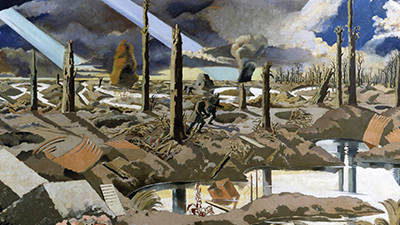Global Conflict
Teacher Resources
Driving Question: What caused the global conflicts from 1914 to 1945, and how did people experience this period of global war?
In this lesson, you will investigate how long-term changes such as nationalism, imperialism, and industrialization set the stage for the two world wars. You will also examine how people around the world experienced these massive conflicts and how global war reshaped societies between 1914 and 1945.
Learning Objectives:
- Use causal thinking to understand how the events of the long nineteenth century contributed to global conflict in the twentieth century.
- Identify major changes and continuities in communities, networks, and production and distribution during this era of global conflict.
Vocab Terms:
- alliance
- authoritarianism
- fascism
- genocide
- Holocaust
- internationalism
- total war
Opener: Global Conflict
To teach this lesson step, refer to page 2 of the Lesson 7.1 Teaching Guide.
Begin learning about the global conflicts of the twentieth century by looking back at the long nineteenth century. You will examine how political, economic, and social changes from earlier eras helped create the tensions that led to World War I.
Looking Ahead
To teach this lesson step, refer to page 3 of the Lesson 7.1 Teaching Guide.
Begin exploring how global tensions led to World War I and World War II, and consider how earlier transformations shaped what came next for people and societies worldwide.
World Wars
To teach this lesson step, refer to page 3 of the Lesson 7.1 Teaching Guide.
This video and article introduce the major themes of global conflict from 1914 to 1945. You’ll explore how two world wars reshaped international systems, devastated societies, and transformed the global balance of power.
-
Guiding Questions
-
Before you watch
Preview the questions below, and then review the transcript.
While you watch
Look for answers to these questions:
- How did the scale of World War I compare to World War II?
- What problems after World War I led to further conflict?
- What economic and political factors encouraged nationalism?
- What were some of the consequences of authoritarianism during World War II?
- What does the data from 1930 to 1944 show about the state of democracy?
After you watch
Respond to this question: Why did some countries shift from democracy to authoritarian and nationalist policies in the 1930s?
Key Ideas
-
Guiding Questions
-
Before you read
Preview the questions below, and then skim the article. Be sure to look at the section headings and any images.
While you read
Look for answers to these questions:
- What were some causes of World War I?
- What does the author say was the most dangerous outcome of World War I?
- What events led to the start of World War II?
- Which two countries were strongest after World War II?
- What was the relationship between those two countries?
After you read
Respond to this question: Why did some countries shift from democracy to authoritarian and nationalist policies in the 1930s?
Framing Unit 7
To teach this lesson step, refer to page 5 of the Lesson 7.1 Teaching Guide.
Use the frames—communities, networks, and production and distribution—to organize your thinking about global conflict. This video and timeline activity will help you connect causes and consequences of the world wars across time and place.
-
Guiding Questions
-
Before you watch
Preview the questions below, and then review the transcript.
While you watch
Look for answers to these questions:
- How did nationalism help cause World War I?
- What is internationalism?
- How did new ideas about community in the 1930s lead to violence in World War II?
- How were global networks weakened by World War I?
- How did production and distribution systems change between the wars?
After you watch
Respond to this question: How do you think strong communities, global networks, or systems of production and distribution could be used to help prevent future wars?
What were the causes, and effects, of both world wars? Let’s see how our three frames can help us understand this question.
Key Ideas
Closer: Global Conflict
To teach this lesson step, refer to page 6 of the Lesson 7.1 Teaching Guide.
A world war doesn’t start over nothing. Use your knowledge of the long nineteenth century and developments like imperialism and colonialism to make predictions about World War I.
Reviewing for Organization and Language/Style
To teach this lesson step, refer to page 6 of the Lesson 7.1 Teaching Guide.
By suggesting revisions to someone else’s writing, you’ll get much better at identifying what makes strong writing. Make suggestions for improving organization and language/style—and then keep those suggestions in mind the next time you write.






